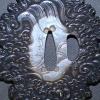新藤五国光 (Shintōgo Kunimitsu) was, in effect, the founder of the Sōshū tradition; three celebrated smiths—Yukimitsu, Masamune, and Norishige—trained under him.
At first glance his workmanship recalls the Yamashiro Awataguchi school, yet the prominent chikei (dark steel lines) and kinsuji (bright “golden” lines) that appear in the steel surface are hallmarks of his blades.
Kunimitsu favored straight hamon (suguha) of varying widths and, as a master of tantō, is considered a peer of Fujishirō Yoshimitsu.
This tantō is forged from well-refined steel showing delicate chikei and is tempered in a neat, narrow suguhahamon.
With a slight inward curve (uchizori), the harmonious balance of its steel texture and hamon gives the piece an appearance of dignity and refinement.


